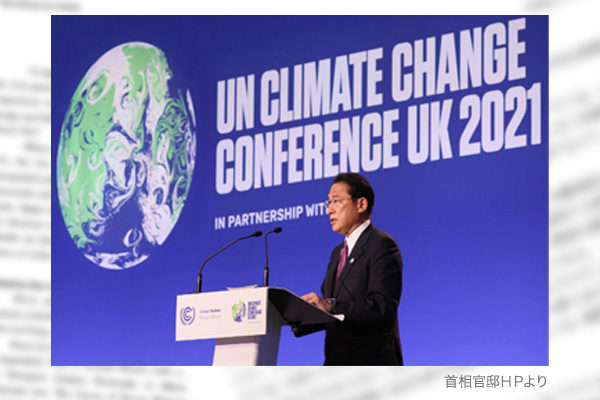On November 2, Japanese Prime Minister Fumio Kishida pledged up to $10 billion in additional support for decarbonization in Asia and other regions at the 26th conference of parties to the United Nations Framework Convention on Climate Change, or COP26, in Glasgow, Britain. As indicated by the video footage of Kishida’s address, however, the conference room was nearly empty. Discussions at the conference were focused on shifting away from coal, leading more than 40 countries to agree. But no industrial country has ever succeeded in effectively reducing CO2 emissions by using solar and wind energy. It would be difficult to phase out coal. The annual COP might have reached a turning point.
Japan’s leading low-carbon coal-burning technologies
While vowing to take leadership in decarbonization in Asia, Kishida did not mention Japan’s goal of cutting global warming gas emissions in fiscal 2030 by 46% from fiscal 2013, but emphasized Japan would use hydrogen and ammonia for achieving carbon neutrality. According to Japan’s Strategic Energy Plan, however, hydrogen and ammonia would account for only 1% of its power generation mix in 2030.
President Xi Jinping of China, the largest greenhouse gas emitter in the world, refrained from attending the conference and just sent a message. So did Russian President Vladimir Putin. Nearly 200 coal-fired power plants are now under construction in Asia, including 28 in India, 95 in China and 23 in Indonesia. These new coal-fired power plants will continue to emit CO2 for decades.
In 2020, coal-fired power generation captured more than 35% of electricity supply in the world. Japan has ultra-supercritical pressure coal power generation technology to emit 17% less CO2 than conventional coal-fired power plants, as well as integrated gasification combined cycle technology to emit 20% less. If CO2 emissions from coal-fired power plants that account for 35% of global power supply is cut by 20%, global emissions will decrease by 7%. Japan accounts for only 3.5% of global CO2 emissions. Even if Japan cuts its emissions by 46%, a decline in global emissions will be only 1.6%. The high-performance coal-fired power generation technologies will make far greater contributions to global emission cuts and allow Japan to take leadership in Asian decarbonization as noted by the prime minister.
France led comeback to nuclear
Germany known for its nuclear phaseout policy had little presence at the COP26. Under the long rule by Chancellor Angela Merkel, Germany has promoted solar, wind, biomass and other renewable energy, the share of which in Germany’s total power generation reached 46% in 2020. But CO2 emissions per kilowatt hour of electricity generated in Germany come to 485 grams, close to 540 grams in Japan. Germany cannot reduce fossil thermal power generation that is used to cover weather-related fluctuations in solar and wind power generation.
France has withdrawn a plan to cut nuclear energy’s share of the power generation mix from 77% to 50% by 2025 and changed direction to come back to nuclear energy. Britain, which serves as the chair of the COP26, decided in October to expand nuclear power generation by introducing many nuclear plants from France’s EDF Energy.
On November 2, Romania announced to introduce U.S.-made small module nuclear reactors by 2028 as agreed between its President Klaus Iohannis and U.S. Special Presidential Envoy for Climate John Kerry. Japan can take advantage of its nuclear power generation technology to make global contributions. As The Wall Street Journal said, “Nuclear power is the best climate-change solution by far.”
Tadashi Narabayashi is a specially appointed professor at the Tokyo Institute of Technology and a director at the Japan Institute for National Fundamentals.


